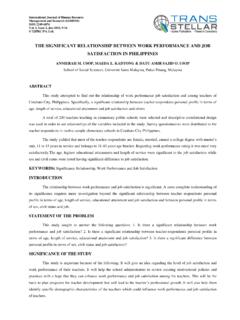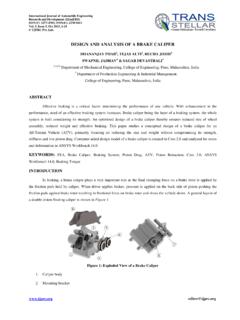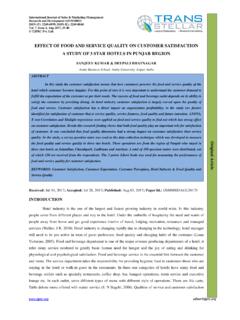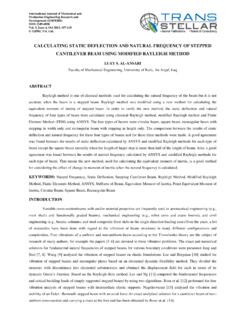Transcription of COEFFICIENT OF FRICTION IN DIFFERENT ROAD …
1 International Journal of Mechanical and Production Engineering Research and Development (IJMPERD). ISSN(P): 2249-6890; ISSN(E): 2249-8001. Vol. 8, Issue 6, Dec 2018, 9-20. TJPRC Pvt. Ltd. COEFFICIENT OF FRICTION IN DIFFERENT road CONDITIONS BY. VARIOUS CONTROL METHODS - AN OVERALL REVIEW. D. SAMUELRAJ, S. JAICHANDAR, B. GOWTHAMA RAJAN & S. GOVINDAN. Department of Automobile Engineering, Vel Tech Rangarajan Dr. Sagunthala R & D Institute of Science & Technology, Chennai, Tamil Nadu, India ABSTRACT. Modern day automotive technology is advancing at a rapid rate resulting in vehicles with outstanding performance and speed. Therefore, the need of the hour is to reengineer and refine existing automotive systems to better suit the requirement of a modern day vehicles. Vehicles with high speed require an equally efficient traction and braking system .
2 In this present work, we study and compare the performance of vehicles under DIFFERENT road conditions using conventional braking , anti -lock braking system and traction control system , and study the relation of COEFFICIENT of FRICTION and wheel slip ratio for DIFFERENT road conditions. In the following project, an experimental setup to imitate tire road interactions is made to collect data of wheel slip and COEFFICIENT of FRICTION under conventional braking , antilock braking system and Traction control system . The obtained data and facts from the experiment is then compared and analysed. The results from the experiments suggest that wheel slip is highest at the peak braking A Review force and although ABS & TCS improve traction and control, it increases the stopping distance of a vehicle proportionally, which can be dangerous in certain scenarios.
3 In conventional braking at 100%, total wheel lock occurs, while in ABS & TCS at 65% slip traction is generally regained. At 65% slip in conventional braking , CoF is in ABS, CoF is and in TCS, CoF is KEYWORDS: CoF, Conventional braking Mechanism, antilock braking system (ABS) & Traction Control system (TCS). Received: Aug 11, 2018; Accepted: Sep 01, 2018; Published: Oct 06, 2018; Paper Id.: IJMPERDDEC20182. 1. introduction . The introduction of controlling the dynamics of wheel in a vehicle was first done in anti -lock braking system to prevent lockup of wheel in an emergency breaking manoeuvre. However, the idea to control wheel dynamics while braking was broadened to control wheel dynamics and other aspects such as engine torque, fuel supply to provide better traction while accelerating and cornering.
4 Thus, traction control system was developed which included ABS into itself, and provided a 20-30% increase in the performance and control of a vehicle. Traction control technology is paramount to vehicle safety in slippery road conditions. Observing wheel slip is the first step in creating a system that controls in real time or prevents large differences between vehicle and wheel speed In the following project, performance of wheel under DIFFERENT road conditions such as rough pavement, smooth pavement, gravel, mud and ice is studied using analysis of COEFFICIENT of FRICTION and slip ratio as study parameter under DIFFERENT road conditions using conventional braking , antilock braking system and Traction control system . SCOPUS Indexed Journal 10 D. Samuelraj, S. Jaichandar, B. Gowthama Rajan & S.
5 Govindan An experimental setup is made to imitate the tire road interactions using wheel a roller and a load motor for the purpose of determining the COEFFICIENT of FRICTION and wheel slip in DIFFERENT road surfaces. Thereafter, the obtained results are compared with the results from other braking methods. Conventional braking Conventional braking is a braking method, which usually involves pulling a lever or pressing a pedal connected to levers or linkages to transmit forces to the brake mechanism consisting of shoe and drum or disc and brake pads, thus generating FRICTION between two surfaces to stop a vehicle. There are three types of conventional braking mechanism Mechanical Brakes Utilizes a cable attached to a brake lever and the brake drum pistons to engage brakes. This mechanism was used in vehicles from the 19th century, and is currently used as parking brake mechanism.
6 Hydraulic Brakes Utilizes a hydraulic pump and a brake oil reservoir connected to the brake pedal to the create pressure to engage brake pistons. These types of systems can be found in regular four wheelers. Pneumatic Brakes Similar to hydraulic, but utilizes air pressure to engage brake pistons. Usually used in heavy industrial and commercial vehicles, as the amount of pressure required to stop such load cannot be achieved using hydraulics. Although conventional braking has the smallest ideal braking distance, it has a major drawback when the maximum brake pressure is applied, the wheels get locked. These results in wheel slip, which causes the vehicle to skid uncontrollably and the driver to lose steering control. Figure : Conventional Brakes Impact Factor (JCC): SCOPUS Indexed Journal NAAS Rating: COEFFICIENT of FRICTION in DIFFERENT road Conditions by 11.
7 Various Control Methods - An Overall Review antilock braking system antilock braking system (ABS) is a safety feature in most modern day vehicles. It utilizes a combination of threshold braking and cadence braking to prevent locking of wheels and wheel slip, when sudden brakes are applied. Rude models of ABS were introduced as early as 1920, but a patented fully functional ABS was introduced in an automobile by Chrysler in 1971 in its Imperial model. Components of ABS. Major components of anti -lock braking system are Electronic control unit (ECU). Hydraulic control Modulator Booster and master cylinder assembly Wheel sensor Figure : ABS Component Layout Objective and Working of ABS. The objective of an ABS is to reduce the ideal stopping distance during sudden braking and provide better steer ability by avoiding skidding of a vehicle, also to maintain stability of the vehicle by controlling longitudinal slip in an operational range.
8 During normal braking , driver controls the brake pedal but when severe braking occurs, the peak brake pressure is detected by sensors, and from there ABS takes over. ECU utilizes a feedback system that responds to wheel slip and deceleration to modulate the brake pressure through booster assembly to reduce the wheel slip for optimal braking performance, and thus preventing the controlled wheel from fully locking. SCOPUS Indexed Journal 12 D. Samuelraj, S. Jaichandar, B. Gowthama Rajan & S. Govindan Figure : Working of ABS. ABS generally offers driver advanced vehicle control in surfaces with low COEFFICIENT of FRICTION , such as muddy and wet roads. ABS generally minimize the stopping distance in slippery and dry surface, conversely on loose surface like gravel or snow covered pavement, ABS can significantly increase braking distance, although still improving vehicle control.
9 Traction Control system Traction control system (TCS) is part of Electronic stability control (ESC). The general function of TCS is to control the sparking sequence, fuel supply and yaw in a vehicle when the vehicle loses traction during high speed, cornering and low speed acceleration. In 1994, Turbo supra was the first vehicle to use traction control system commercially. Components of TCS. Major components of traction control system are same as anti -locking braking with few additional systems in the engine bay. Solenoid engine valve controls Control valves in Fuel pump Booster and master cylinder assembly Wheel sensor Hydraulic control Modulator (6 solenoids). Electronic control unit (ECU). Impact Factor (JCC): SCOPUS Indexed Journal NAAS Rating: COEFFICIENT of FRICTION in DIFFERENT road Conditions by 13.
10 Various Control Methods - An Overall Review Figure : Components of TCS. Objective and Working of TCS. Seasonal changes and variable temperatures often take a hard toll on road conditions. Traction control can give stability and control in roads with low FRICTION , and helps in sudden acceleration without wheel spinning Traction control system works in multiple ways to control the rotational speed of wheel to provide maximum traction. When the wheel sensors detect a wheel spin, it engages the fuel pump solenoid valves to reduce engine power and regain traction. The driver may experience a pulsation in the gas pedal similar to the brake pedal in ABS. Another method TCS utilizes is, a combination of engine power reduction and wheel braking to achieve required traction and vehicle stability.













